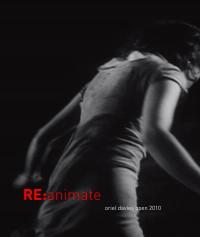[main]
The overarching project grew from a single improvised performance with sound and video called The Velvet Lantern. This entailed the depopulation of some examples of 'classical' cinema – in other words identifying short clips (sometimes as short as two frames) from films such as The 39 Steps where there is no significant evidence of people in the shot. This provided the performers with a makeshift 'rear projection' to extend the theatrical space into various environments: the shots of the hall and the stone-age ruins in The Hound of the Baskervilles (1939); the nature scenes from The Edge of the World (1937); the views of the Cornish sea in Jamaica Inn (1939); and so on. These environments would impose themselves behind the performers at various points over the course of the day, often with 'procedural audio' techniques to create unique sound effects over the improvised soundtrack.
The rear projections were not confined to an attempt at verisimilitude. Often the perspectives changed – a steady view of a landscape with the horizon at eye level might be replaced by a view down a cliffside to the sea. And scale would shift when a hand lighting an oil lamp would fill the backcloth, creating a gigantism reminiscent of the drawings of Fuseli. These short clips would be variously looped and read back-and-forth, allowing me to dwell on them for any desired length of time.
The heroine from Jamaica Inn is glimpsed at the end of the performance. This was a clip of her looking over the cliff edge. In the source this shot lasts 50 frames or so. By a process of interpolation – a variant on the idea of 'tweening' in animation – the clip was extended to 10,000 frames. Essentially, I had supplemented the original clip with a large set of micro-movements between the frames allowing for very slow and smooth playback. These are imagined movements between the frames captured by Hitchcock's camera. This segment forms a key part of the later piece, In Slower Motion, both materially and thematically.

Produced for presentation at Sonic Artists in Wales, this version of the first part used a multi-channel sound system to distribute the 'procedural audio'-based soundtrack around the audience.
Procedural audio (see Andy Farnell, 'Designing Sound') is a strategy for synthesising sounds, notably sound effects, so that variations can be programmed into their use. This means that no sound need be identical each time it is used. This approach aligns with my belief that continually running installations need to break away from a reliance on fixed media approaches and seek ways of creating continual variation. Even the use of 'sampled' materials (video is a form of sampling as much as digital audio) can be subject to change in its presentation through digital processing. Editing can also happen in real time and without predicted results, if desired. This is a strategy I adopt from the outset in many works.
In this work, for example, a bell is seen tolling. This clip is called up at will during performance and the accompanying sound is generated using FM (frequency modulation) synthesis where the parameters are automatically varied subtly on each strike, resulting in a slightly different bell sound each time. The sound is synchronised to a particular frame in the clip and is triggered whenever the frame is shown.
This performed version was an opportunity to deal directly with the possibilities of live editing.

This was a fixed media version with a fixed soundtrack for exhibition purposes. It was essentially a recorded version of Part 1b. Shown at Oriel Davies Gallery, Newtown.
With the support of Chapter / Experimentica